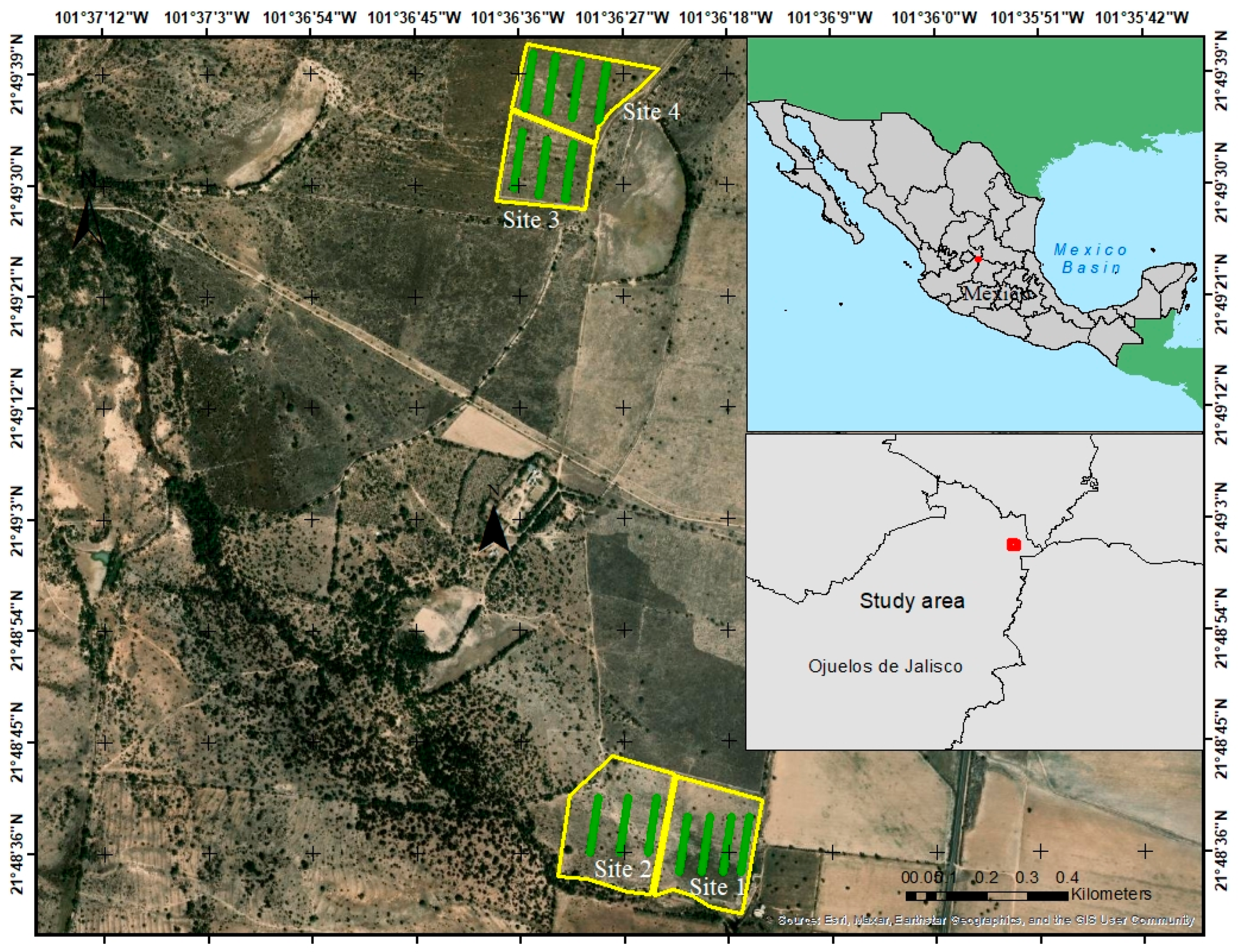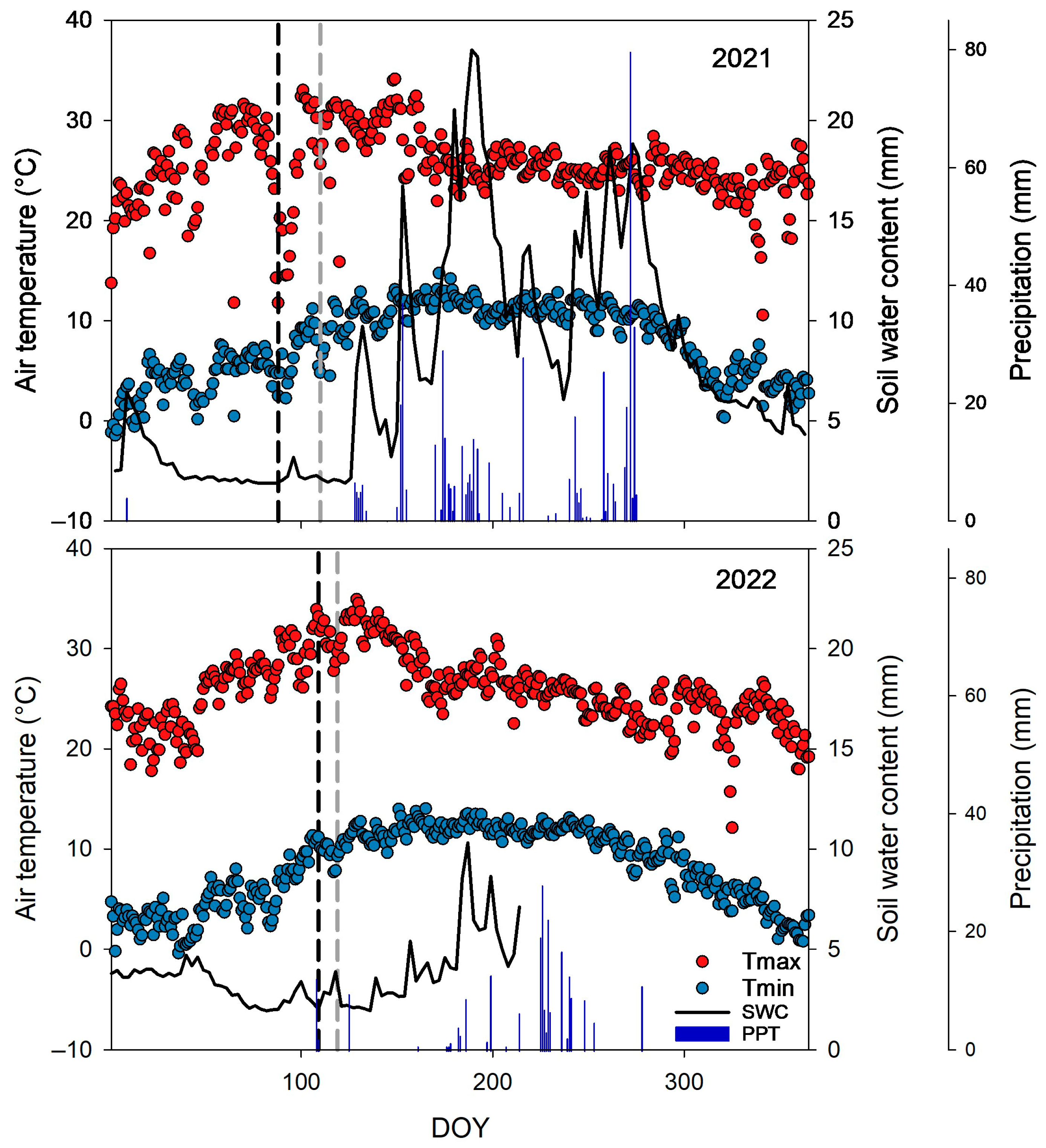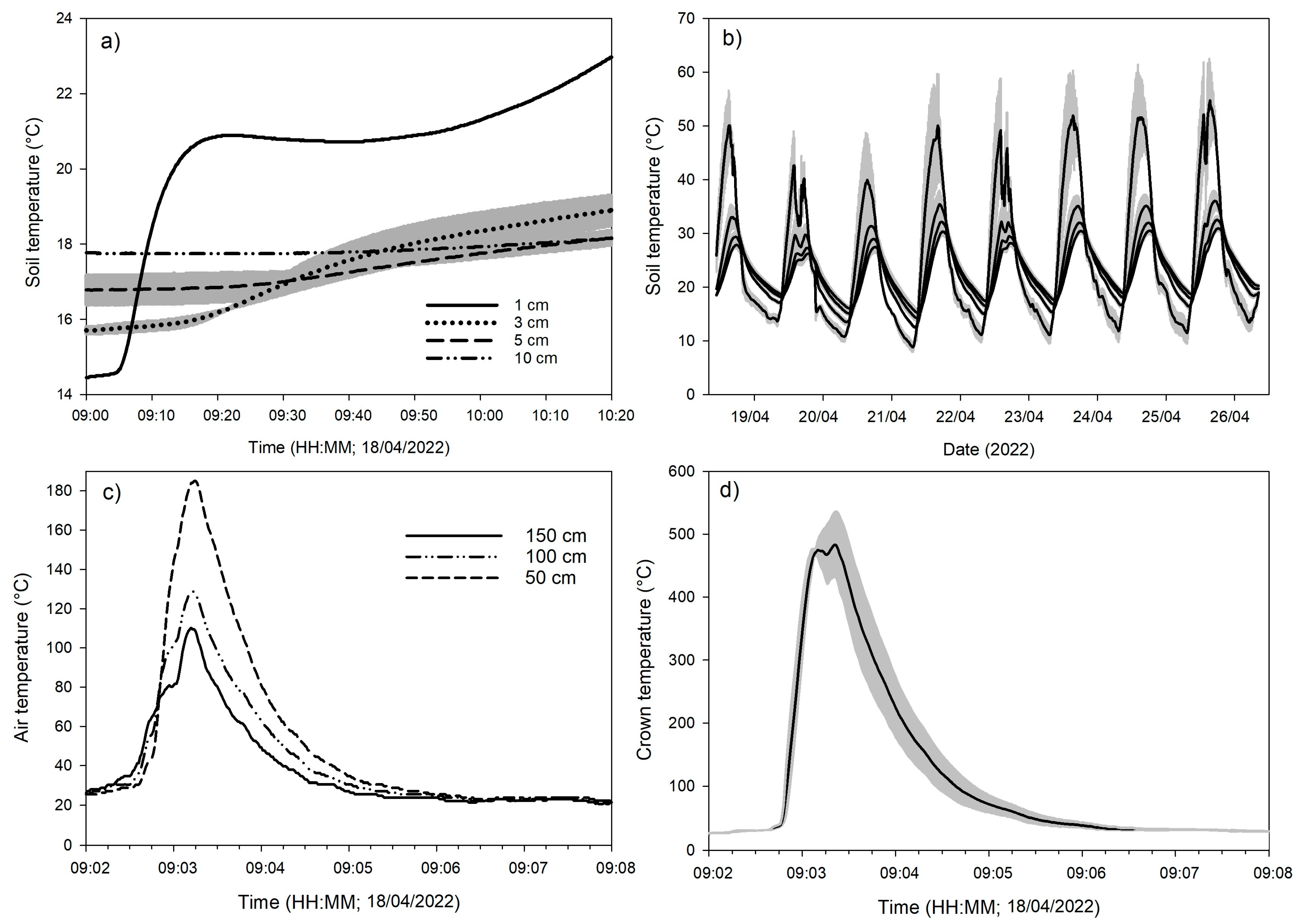Prescribed Burns Reduce Early-Stage Shrub Encroachment in Semi-arid Grassland
Abstract
1. Introduction
2. Materials and Methods
2.1. Study Area
2.2. Vegetation Cover
2.3. Climate
2.4. History and Grazing Management
2.5. Experimental Design
2.6. Vegetation Sampling
2.7. Application of Prescribed Burns
2.8. Environmental Variables
2.9. Analysis of Data
3. Results
3.1. Species Composition
3.2. Prevailing Weather Conditions
3.3. Temperatures in Prescribed Burnings
3.4. Fire Effects on Shrubs
4. Discussion
4.1. Fire Effects on Shrubs
4.2. Research Limitations
4.3. Future Research
5. Conclusions
Supplementary Materials
Author Contributions
Funding
Institutional Review Board Statement
Informed Consent Statement
Data Availability Statement
Acknowledgments
Conflicts of Interest
References
- Huenneke, L.F.; Clason, D.; Muldavin, E. Spatial heterogeneity in Chihuahuan Desert vegetation: Implications for sampling methods in semi-arid ecosystems. J. Arid. Environ. 2001, 47, 257–270. [Google Scholar] [CrossRef]
- Rzedowski, J. Flora of the Valley of Mexico, 2nd ed.; Institute of Ecology: Mexico City, Mexico, 2021. [Google Scholar]
- Barger, N.N.; Archer, S.R.; Campbell, J.L.; Huang, C.Y.; Morton, J.A.; Knapp, A.K. Woody plant proliferation in North American drylands: A synthesis of impacts on ecosystem carbon balance. J. Geophys. Res. Biogeosci. 2011, 116, G00K07. [Google Scholar] [CrossRef]
- Van Auken, O.W. Shrub invasions of North American semiarid grasslands. Annu. Rev. Ecol. Syst. 2000, 31, 197–215. [Google Scholar] [CrossRef]
- Caldeira, M.C.; Lecomte, X.; David, T.S.; Pinto, J.G.; Bugalho, M.N.; Werner, C. Synergy of extreme drought and shrub invasion reduce ecosystem functioning and resilience in water-limited climates. Sci. Rep. 2015, 5, 15110. [Google Scholar] [CrossRef]
- Kidron, G.J.; Gutschick, V.P. Soil moisture correlates with shrub–grass association in the Chihuahuan Desert. Catena 2013, 107, 71–79. [Google Scholar] [CrossRef]
- Mullins, E.A. Native Plant Allelopathy: A Potential Approach to Limit Invasive Grass Encroachment in Thorn Forest Restoration. Master’s Thesis, The University of Texas Rio Grande Valley, Edinburg, TX, USA, 2020. [Google Scholar]
- Mata-González, R.; Figueroa-Sandoval, B.; Clemente, F.; Manzano, M. Vegetation changes after livestock grazing exclusion and shrub control in the southern Chihuahuan Desert. West. N. Am. Nat. 2007, 67, 63–70. [Google Scholar] [CrossRef]
- Munson, S.M.; Muldavin, E.H.; Belnap, J.; Peters, D.P.; Anderson, J.P.; Reiser, M.H.; Christiansen, T.A. Regional signatures of plant response to drought and elevated temperature across a desert ecosystem. Ecology 2013, 94, 2030–2041. [Google Scholar] [CrossRef]
- Sepp, S.K.; Davison, J.; Moora, M.; Neuenkamp, L.; Oja, J.; Roslin, T.; Zobel, M. Woody encroachment in grassland elicits complex changes in the functional structure of above-and belowground biota. Ecosphere 2021, 12, e03512. [Google Scholar] [CrossRef]
- Ibarra Flores, F.A.; Martín Rivera, S.; Moreno Medina, M.; Denogean Ballesteros, F.G.; Martinez Duran, A.B.; Retes López, R.; Aguilar Valdes, A. Beneficios económicos asociados con el control de invasiones de uña de gato en el pastizal mediano abierto de Cananea, Sonora, México. Rev. Mex. Agronegocios 2014, 34, 795–805. [Google Scholar] [CrossRef]
- Osborn, S.; Wright, V. Understanding and Managing Invasive Plants in Wilderness and Other Natural Areas: An Annotated Reading List; U.S. Department of Agriculture, Forest Service, Rocky Mountain Research Station: Fort Collins, CO, USA, 2002; Volume 4.
- Rego, F.; Rigolot, E.; Fernandes, P.; Montiel, C.; Silva, J.S. Towards integrated fire management. EFI Policy Brief 2010, 4, 16. [Google Scholar]
- Wright, H.A.; Bailey, A.W. Fire Ecology: United States and Southern Canada; John Wiley & Sons, Inc.: New York, NY, USA, 1982. [Google Scholar]
- Nippert, J.B.; Telleria, L.; Blackmore, P.; Taylor, J.H.; O’Connor, R.C. Is a prescribed fire sufficient to slow the spread of woody plants in an infrequently burned grassland? A case study in tallgrass prairie. Rangel. Ecol. Manag. 2021, 78, 79–89. [Google Scholar] [CrossRef]
- Hahn, G.E.; Coates, T.A.; Aust, W.M. Soil chemistry following single-entry, dormant season prescribed fires in the Ridge and Valley Province of Virginia, USA. Commun. Soil Sci. Plant Anal. 2021, 52, 2065–2073. [Google Scholar] [CrossRef]
- Ratajczak, Z.; Nippert, J.B.; Ocheltree, T.W. Abrupt transition of mesic grassland to shrubland: Evidence for thresholds, alternative attractors, and regime shifts. Ecology 2014, 95, 2633–2645. [Google Scholar] [CrossRef]
- Ratajczak, Z.; D’Odorico, P.; Nippert, J.B.; Collins, S.L.; Brunsell, N.A.; Ravi, S. Changes in spatial variance during a grassland to shrubland state transition. J. Ecol. 2017, 105, 750–760. [Google Scholar] [CrossRef]
- Grice, A.C. Post-fire regrowth and survival of the invasive tropical shrubs Cryptostegia grandiflora and Ziziphus mauritiana. Aust. J. Ecol. 1997, 22, 49–55. [Google Scholar] [CrossRef]
- Rodríguez-Trejo, D.A.; Pausas, J.G.; Miranda-Moreno, A.G. Plant responses to fire in a Mexican arid shrubland. Fire Ecol. 2019, 15, 11. [Google Scholar] [CrossRef]
- Twidwell, D.; Rogers, W.E.; Wonkka, C.L.; Taylor, C.A.; Kreuter, U.P. Extreme prescribed fire during drought reduces survival and density of woody resprouters. J. Appl. Ecol. 2016, 53, 1585–1596. [Google Scholar] [CrossRef]
- Ansley, R.J.; Mirik, M.Y.; Castellano, M.J. Partición estructural de biomasa en mezquite (Prosopis glandulosa) en rebrote y no perturbado: Implicaciones para los usos de la bioenergía. Glob. Change Biol. Bioenergy 2010, 2, 26–36. [Google Scholar] [CrossRef]
- Hopkinson, P.; Hammond, M.; Bartolome, J.W.; Macaulay, L. Using consecutive prescribed fires to reduce shrub encroachment in grassland by increasing shrub mortality. Restor. Ecol. 2020, 28, 850–858. [Google Scholar] [CrossRef]
- Ling, H.; Wang, G.; Wu, W.; Shrestha, A.; Innes, J.L. Grassland Resilience to Woody Encroachment in North America and the Effectiveness of Using Fire in National Parks. Climate 2023, 11, 219. [Google Scholar] [CrossRef]
- Fuhlendorf, S.D.; Limb, R.F.; Engle, D.M.; Miller, R.F. Assessment of prescribed fire as a conservation practice. In Conservation Benefits of Rangeland Practices: Assessment, Recommendations, and Knowledge Gaps; Brisk, D.D., Ed.; United States Department of Agriculture, Natural Resources Conservation Service: Washington, DC, USA, 2011; pp. 75–104. [Google Scholar]
- Kittams, W.H. Effect of fire on vegetation of the Chihuahuan Desert region. In Proceedings of the Annual Tall Timbers Fire Ecology Conference, Lubbock, TX, USA, 8–9 June 1972; Volume 12, pp. 427–444. Available online: https://talltimbers.org/wp-content/uploads/2018/09/427-Kittams1972_op.pdf (accessed on 15 October 2024).
- Watson, P.A.; Alexander, H.D.; Moczygemba, J.D. Coastal Prairie Recovery in Response to Shrub Removal Method and Degree of Shrub Encroachment. Rangel. Ecol. Manag. 2019, 72, 275–282. [Google Scholar] [CrossRef]
- Ramírez, F.; Enríquez, E.; Miranda, H.; Ortega, C.; Silva, M. Control de huizache (Acacia farnesiana) con tebuthiuron en la parte central de Sonora. Técnica Pecu. México 1998, 36, 243–248. Available online: https://cienciaspecuarias.inifap.gob.mx/index.php/Pecuarias/article/view/623/621 (accessed on 1 October 2024).
- INEGI. Conjunto de Datos Vectorial Edafológico. Escala 1:250000. Serie II. Continuo Nacional; Instituto Nacional de Estadística y Geografía: Aguascalientes, Mexico, 2007.
- Aguado-Santacruz, G.A.; Garcia-Moya, E. Environmental factors and community dynamics at the southernmost part of the North American Graminetum—I. On the contribution of climatic factors to temporal variation in species composition. Plant Ecol. 1998, 135, 13–29. [Google Scholar] [CrossRef]
- Rodríguez, M.V.M. ESSENGER. Sistema de Base de Datos Meteorológicos. X Congreso Nacional Sobre Conservación y Utilización de los Recursos Zoogenéticos. XXII Simposio Iberoamericano y X Congreso Nacional CONBIAND; Noviembre. RPDA INIFAP-03-2021-120109052200-01; Benemérita Universidad Autónoma de Puebla: Puebla de Zaragoza, México, 2021; Available online: https://clima.inifap.gob.mx/lnmysr/DatosIndirectos/NEssenger (accessed on 17 January 2025).
- Abatzoglou, J.; Dobrowski, S.; Parks, S.; Hegewisch, K.C. TerraClimate, a high-resolution global dataset of monthly climate and climatic water balance from 1958–2015. Sci. Data 2018, 5, 170191. [Google Scholar] [CrossRef]
- R Core Team. A: A Language and Environment for Statistical Computing; R Foundation for Statistical Computing: Vienna, Austria, 2020; Available online: https://www.R-project.org/ (accessed on 6 July 2024).
- Archer, S.R.; Andersen, E.M.; Predick, K.I.; Schwinning, S.; Steidl, R.J.; Woods, S.R. Woody plant encroachment: Causes and consequences. In Rangeland Systems; Briske, D.D., Ed.; Springer Series on Environmental Management; Springer: Cham, Switzerland, 2017. [Google Scholar] [CrossRef]
- Ludwig, F.; de Kroon, H.; Prins, H.H.; Berendse, F. Effects of nutrients and shade on tree-grass interactions in an East African savanna. J. Veg. Sci. 2001, 12, 579–588. [Google Scholar] [CrossRef]
- Harrington, J.A.; Kathol, E. Responses of shrub midstory and herbaceous layers to managed grazing and fire in a North American savanna (oak woodland) and prairie landscape. Restor. Ecol. 2009, 17, 234–244. [Google Scholar] [CrossRef]
- Ratajczak, Z.; Nippert, J.B.; Briggs, J.M.; Blair, J.M. Fire dynamics distinguish grasslands, shrublands and woodlands as alternative attractors in the Central Great Plains of North America. J. Ecol. 2014, 102, 1374–1385. [Google Scholar] [CrossRef]
- Bennett, L.T.; Judd, T.S.; Adams, M.A. Growth and nutrient content of perennial grasslands following burning in semi-arid, sub-tropical Australia. Plant Ecol. 2003, 164, 185–199. [Google Scholar] [CrossRef]
- Wells, A.G.; Munson, S.M.; Sesnie, S.E.; Villarreal, M.L. Remotely sensed fine-fuel changes from wildfire and prescribed fire in a semi-arid grassland. Fire 2021, 4, 84. [Google Scholar] [CrossRef]
- Holdo, R.M.; Brocato, E.R. Tree–grass competition varies across select savanna tree species: A potential role for rooting depth. Plant Ecol. 2015, 216, 577–588. [Google Scholar] [CrossRef]
- Pierce, N.A.; Archer, S.R.; Bestelmeyer, B.T. Competition suppresses shrubs during early, but not late, stages of arid grassland–shrubland state transition. Funct. Ecol. 2019, 33, 1480–1490. [Google Scholar] [CrossRef]
- Bond, W.J.; Midgley, J.J. The evolutionary ecology of sprouting in woody plants. Int. J. Plant Sci. 2003, 164, S103–S114. [Google Scholar] [CrossRef]
- Li, J.; Ravi, S.; Wang, G.; Van Pelt, R.S.; Gill, T.E.; Sankey, J.B. Woody plant encroachment of grassland and the reversibility of shrub dominance: Erosion, fire, and feedback processes. Ecosphere 2022, 13, e3949. [Google Scholar] [CrossRef]
- Teveni, P.C. Characterizing Temporal Ecophysiology for Chemical Management of Huisache (Acacia farnesiana [L.] Willd.). Ph.D. Thesis, Texas Tech University, Lubbokc, TX, USA, 2017; 109p. [Google Scholar]
- Weber-Grullon, L.; Gherardi, L.; Rutherford, W.A.; Archer, S.R.; Sala, O.E. Woody-plant encroachment: Precipitation, herbivory, and grass-competition interact to affect shrub recruitment. Ecol. Appl. 2022, 32, e2536. [Google Scholar] [CrossRef] [PubMed]
- Yang, J.; Will, R.; Zhai, L.; Zou, C. Future climate change shifts the ranges of major encroaching woody plant species in the Southern Great Plains, USA. Earth Future 2024, 12, e2024EF004520. [Google Scholar] [CrossRef]
- Scholtz, R.; Smit IP, J.; Coetsee, C.; Kiker, G.A.; Venter, F.J. Legacy effects of top–down disturbances on woody plant species composition in semi-arid systems. Austral. Ecol. 2017, 42, 72–83. [Google Scholar] [CrossRef]
- Capozzelli, J.F.; Miller, J.R.; Debinski, D.M.; Schacht, W.H. Restoring the fire–grazing interaction promotes tree–grass coexistence by controlling woody encroachment. Ecosphere 2020, 11, e02993. [Google Scholar] [CrossRef]
- Jordan, S. The Interactive Effects of Precipitation and Disturbance on the Functioning of Dryland Ecosystems as Modulated by Mean Annual Precipitation. Ph.D. Thesis, Arizona State University, Tempe, AZ, USA, 2024. Available online: https://d1rbsgppyrdqq4.cloudfront.net/s3fs-public/c7/Jordan_asu_0010E_23982.pdf?versionId=R2akym8Eqa_l2uPz.h6jIBvmut.b9zS3&X-Amz-Content-Sha256=UNSIGNED-PAYLOAD&X-Amz-Algorithm=AWS4-HMAC-SHA256&X-Amz-Credential=AKIASBVQ3ZQ4YNQVYJLW/20250129/us-west-2/s3/aws4_request&X-Amz-Date=20250129T181905Z&X-Amz-SignedHeaders=host&X-Amz-Expires=120&X-Amz-Signature=646b062110ccbb465287f61b0cc48343f79ebe220379f27c6c4f684b027608b4 (accessed on 15 December 2024).
- Wright, H.A. Range burning. J. Range Manag. Arch. 1974, 27, 1–11. [Google Scholar] [CrossRef]
- Jones, G.M.; Tingley, M.W. Pyrodiversity and biodiversity: A history, synthesis, and outlook. Divers. Distrib. 2022, 28, 386–403. [Google Scholar] [CrossRef]
- Biederman, J.A.; Scott, R.L.; Arnone, J.A., III; Jasoni, R.L.; Litvak, M.E.; Moreo, M.T.; Vivoni, E.R. Shrubland carbon sink depends upon winter water availability in the warm deserts of North America. Agric. For. Meteorol. 2018, 249, 407–419. [Google Scholar] [CrossRef]
- Ascoli, D.; Lonati, M.; Marzano, R.; Bovio, G.; Cavallero, A.; Lombardi, G. Prescribed burning and browsing to control tree encroachment in southern European heathlands. For. Ecol. Manag. 2013, 289, 69–77. [Google Scholar] [CrossRef]
- Pausas, J.G.; Pratt, R.B.; Keeley, J.E.; Jacobsen, A.L.; Ramirez, A.R.; Vilagrosa, A.; Davis, S.D. Towards understanding resprouting at the global scale. New Phytol. 2016, 209, 945–954. [Google Scholar] [CrossRef]
- O’Connor, R.C.; Taylor, J.H.; Nippert, J.B. Browsing and fire decreases dominance of a resprouting shrub in woody encroached grassland. Ecology 2020, 101, e02935. [Google Scholar] [CrossRef]
- Delgado-Balbuena, J.; Arredondo, J.T.; Loescher, H.W.; Pineda-Martínez, L.F.; Carbajal, J.N.; Vargas, R. Seasonal precipitation legacy effects determine the carbon balance of a semiarid grassland. J. Geophys. Res. Biogeosci. 2019, 124, 987–1000. [Google Scholar] [CrossRef]
- Sala, O.E.; Gherardi, L.A.; Reichmann, L.; Jobbágy, E.; Peters, D. Legacies of precipitation fluctuations on primary production: Theory and data synthesis. Philos. Trans. R. Soc. Lond. Ser. B Biol. Sci. 2012, 367, 3135–3144. [Google Scholar] [CrossRef] [PubMed]
- Taylor, C. Fire Ecology in the Central Texas and Edwards Plateau Regions of Texas. In Symposium for Land Managers; University of Texas Press: Kerrville, TX, USA, 2025; pp. 32–41. Available online: http://texnat.tamu.edu/files/2010/09/fireproceedings21.pdf (accessed on 1 December 2024).





| Species | Biomass Contribution (%) |
|---|---|
| Living grass standing biomass | 63.305 |
| Dalea Bicolor | 14.961 |
| Bidens sp. | 6.936 |
| Dead grass standing biomass | 6.545 |
| No ID | 3.837 |
| Plantago lanceolata | 2.695 |
| Stevia serrata | 1.075 |
| Euphorbia | 0.243 |
| Paspalum sp. | 0.190 |
| Zornia reticulata | 0.079 |
| Phaseolus sp. | 0.057 |
| Dichondra sp. | 0.041 |
| Tagetes sp. | 0.013 |
| Cyperus sp. | 0.012 |
| Sida sp. | 0.010 |
| Vachellia schaffneri | 0.002 |
| Species | Explanatory Variable | Relative Importance (%) | |
|---|---|---|---|
| Fire damage | Number of resprouts | ||
| Vachellia schafneri | |||
| Crown diameter | 53.1 | 28.7 | |
| Base diameter | 24.7 | 65.2 | |
| Height | 22.2 | 6.1 | |
| Mimosa biuncifera | |||
| Crown diameter | 60.0 | ||
| Base diameter | 30.2 | ||
| Height | 9.8 | ||
| M. biuncifera | V. schaffneri | |||
|---|---|---|---|---|
| Dead Shrubs | Alive Shrubs | Dead Shrubs | Alive Shrubs | |
| Base diameter (cm) | * | * | ||
| Height (m) | ||||
| Crown area (m2) | * | |||
Disclaimer/Publisher’s Note: The statements, opinions and data contained in all publications are solely those of the individual author(s) and contributor(s) and not of MDPI and/or the editor(s). MDPI and/or the editor(s) disclaim responsibility for any injury to people or property resulting from any ideas, methods, instructions or products referred to in the content. |
© 2025 by the authors. Licensee MDPI, Basel, Switzerland. This article is an open access article distributed under the terms and conditions of the Creative Commons Attribution (CC BY) license (https://creativecommons.org/licenses/by/4.0/).
Share and Cite
Alfaro-Reyna, T.; Aguirre-Gutierrez, C.A.; de la Cruz Domínguez, J.C.; Luna Luna, M.; Flores-Rentería, D.; Delgado-Balbuena, J. Prescribed Burns Reduce Early-Stage Shrub Encroachment in Semi-arid Grassland. Fire 2025, 8, 71. https://doi.org/10.3390/fire8020071
Alfaro-Reyna T, Aguirre-Gutierrez CA, de la Cruz Domínguez JC, Luna Luna M, Flores-Rentería D, Delgado-Balbuena J. Prescribed Burns Reduce Early-Stage Shrub Encroachment in Semi-arid Grassland. Fire. 2025; 8(2):71. https://doi.org/10.3390/fire8020071
Chicago/Turabian StyleAlfaro-Reyna, Teresa, Carlos Alberto Aguirre-Gutierrez, Juan Carlos de la Cruz Domínguez, Miguel Luna Luna, Dulce Flores-Rentería, and Josué Delgado-Balbuena. 2025. "Prescribed Burns Reduce Early-Stage Shrub Encroachment in Semi-arid Grassland" Fire 8, no. 2: 71. https://doi.org/10.3390/fire8020071
APA StyleAlfaro-Reyna, T., Aguirre-Gutierrez, C. A., de la Cruz Domínguez, J. C., Luna Luna, M., Flores-Rentería, D., & Delgado-Balbuena, J. (2025). Prescribed Burns Reduce Early-Stage Shrub Encroachment in Semi-arid Grassland. Fire, 8(2), 71. https://doi.org/10.3390/fire8020071







